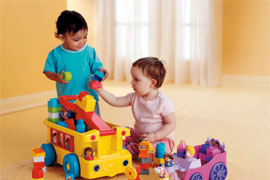Learning Through Play: Why It’s Important

When it comes to toys, how do you choose the right ones for your baby? What are the key components you should be considering? Childhood development expert, Dr. Deborah Weber shares some key points.
Q. How important is it for baby toys to have educational components? Can toys really help babies learn according to their milestones?
A. What’s most important is to provide a variety of toys—and babies learn from all toys in addition to toys that have educational components such as the A,B,C’s or 1,2,3’s. Educational toys provide babies with an opportunity to learn through play—they are exposed to the different sounds, names of objects, and sing along songs that introduce different concepts and content such as colours, shapes, and numbers. Toys encourage and support the development of important skills in children as they play, such as motor skills, problem solving, creative thinking, socialization, etc. Toys can help babies learn according to their milestones such as providing the opportunity to use their senses, imagine, discover, learn and create.
Q. Can my baby be over-stimulated? Is there such a thing as too much stimulation?
A. Babies have an inborn response mechanism to ignore or turn away from over-stimulation, so if you notice your child continually turning away or becoming fussy, check the surroundings to see if there is too much going on. Some distractions you may not be able to control, but some you can. For example, if there is a loud television, radio, or if your baby is playing with a toy that has sounds and lights, you could eliminate some of the distracting elements. Knowing this, when we design toys for infants, we incorporate short musical responses and have action reaction momentary responses that give the child control. You don’t want to avoid stimulation because it is important to provide it; however, you want to be on guard for over-stimulation.
Q. Brands such as Fisher-Price emphasize that a lot of research and testing goes into how they design their toys. Does it really matter how sophisticated a toy is when sometimes babies/toddlers just play with the box?
A. You are so right—babies love to play with things as simple as a box! They enjoy climbing into and out of the box and discovering what else they can do with it. What we look for when testing toys at Fisher-Price is whether or not babies/toddlers enjoy and are interested in interacting and playing with the toys too. Are the toys engaging and invite repeat play, do they offer child interaction and progressive challenges that address developing needs yet are not frustrating to the child? We take great care to include a variety of play features in toys to encourage imagination and an opportunity for children to fully enjoy and have fun playing while they experience the developmental benefits the toys provide. It’s great to provide a variety of toys and objects for babies/toddler to play with along with things as simple as a box—because they stimulate their curiosity, creativity, and imagination.
Q. Babies grow so quickly, is it possible to find toys they will play with for more than a week?
A. There are a lot of great toys that have multiple ways to play and grow with your child. For example, the Fisher-Price Kick ‘n Play Piano can be used in the crib and then as a floor toy. There are also baby walkers that transform into a toy to ride-on, soft gyms that offer different modes of play from laying on your back, to tummy time, to sitting up; mobiles that transform into crib side soothers are great too! Other examples of types of toys that babies play with for longer periods of time are early role play items such as pretend food or cooking items, blocks, balls, zoo or farm animal figures, and dolls.
Q. What should I look for when picking toys for my baby/toddler? How can I tell a toy is safe?
A. Babies and toddlers like toys with: buttons to press, knobs to turn, action-and-reaction, put-and-take, stacking-and-nesting, colourful activities, lights-and-sounds, textures to touch, surprises, happy faces. They are attracted to bold, contrasting colours and simple but interesting patterns. They like listening and moving to lively, rhythmical music, as well as listening and falling asleep to soothing lullabies. Regarding how to tell if a toy is safe, check to be sure it is manufactured by a reputable toy company that indicates they meet safety regulations. Follow the recommended age grades on the package. The age recommendation provided by the manufacturer of the toy will give you the age the toy is safe and appropriate for.














